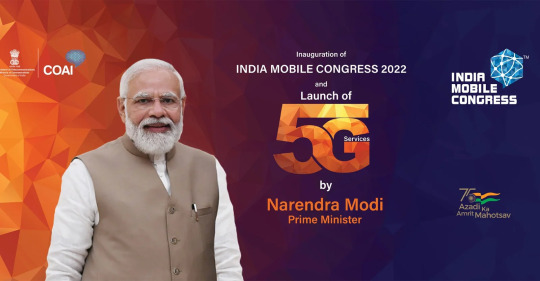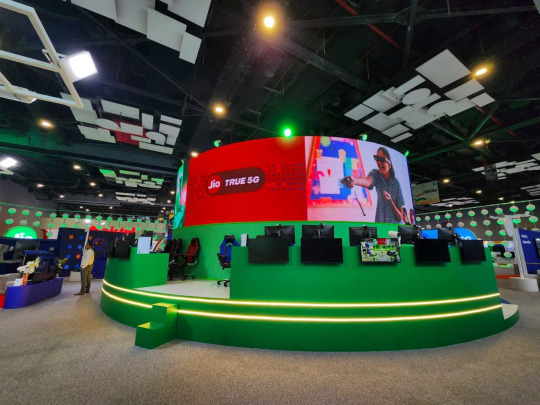#India Mobile Congress
Explore tagged Tumblr posts
Text
#India Mobile Congress#Department of Telecommunications#COAI#telecom#digitaltransformation#TelecomInnovation#IIITB#DigitalTransformation#TechShowcase#electronicsnews#technologynews
0 notes
Text
India Mobile Congress 2024: Jio Chairman Akash Ambani Has Two Suggestions For PM Modi
India Mobile Congress (IMC) 2024 kicked off today, October 15, highlighting India’s advances in 6G technology and the latest innovations in telecommunications. With the theme ‘The Future is Now’, the event is expected to showcase 5G applications from leading telecom players, along with updates on cloud and edge computing, IoT, cybersecurity, semiconductors, green technology, satellite…
#6G#AI#Akash Ambani#Akash ambani narendra modi#IMC 2024#India Mobile Congress#Jio#Jio narendra modi#Modi 6G#Narendra Modi#Reliance#Reliance Jio#Technology#World Telecommunication Standardization Assembly#WTSA#WTSA 2024
0 notes
Text

⚡We are immensely proud to have participated in the Indian Mobile Congress 2023 held in Delhi. The event featured prominent leaders in the telecommunications industry, insightful business advisors, and enthusiastic attendees. Our presence at the event was marked by dynamic presentations showcasing our latest innovations and engaging in meaningful discussions.⚡
We extend our heartfelt gratitude to all those who visited our booth. Your enthusiasm and support propelled us towards excellence
#IMC #IMC2023 #indiamobilecongress #mobilecongress #greenadsglobal
0 notes
Text
PM Modi Inaugurates the 7th India Mobile Congress: A Leap into the Digital Future
The 7th India Mobile Congress, a premier event in the sphere of technology and innovation, has been inaugurated by Prime Minister Narendra Modi at Bharat Mandapam in Delhi. This grand event is a testament to India's expanding role in the global digital landscape and its commitment to technological advancement and digital transformation.
This event brings together the brightest minds in technology and innovation to discuss and showcase the latest advancements. As India makes a move into the digital future, the Congress serves as a platform for collaboration, innovation, and the exchange of ideas. It's a reminder that India's journey into the digital era is more than just a technological shift; it's a path to empower, connect, and transform the lives of millions.
Check out these details to know more about the India Mobile Congress and the role it plays.
1. India's Digital Transformation:

The India Mobile Congress is more than just an event; it's a reflection of India's digital transformation journey. With initiatives like Digital India and Start-up India, the country is utilizing the power of technology to connect, empower, and transform the lives of its citizens.
To Read More Click here...
#hot news#latest news#latest updates#new version#new updates#new technology#trending topic#trending news blog#india mobile congress#Digital future
0 notes
Text
India Mobile Congress : इंडिया मोबाइल कांग्रेस के 7वें संस्करण का पीएम ने किया उद्घाटन
नई दिल्ली। India Mobile Congress : आज दिल्ली के प्रगति मैदान में इंडिया मोबाइल कांग्रेस के 7वें संस्करण का प्रधानमंत्री नरेंद्र मोदी ने उद्घाटन किया। इस दौरान रिलायंस जियो इन्फोकॉम लिमिटेड के चेयरमैन आकाश अंबानी ने प्रधानमंत्री को दूरसंचार के क्षेत्र में उनकी कंपनी द्वारा किए जा रहे कार्यों के बारे में बताया। इस कार्यक्रम में इनोवेशन और तकनीक से जुड़े कई अपडेट पेश किए जाएंगे। Israel-Hamas :…

View On WordPress
#hindi news#India Mobile Congress#प्रधानमंत्री नरेंद्र मोदी#रिलायंस जियो इन्फोकॉम लिमिटेड के चेयरमैन आकाश अंबानी
0 notes
Text
#India Mobile Congress 2024#technology#innovations#collaboration#powerelectronics#powermanagement#powersemiconductor
0 notes
Text

Join Lepton Software at India Mobile Congress 2024, (Official GIS Partner) as we showcase our GIS-Powered Telecom Solutions.
NetworkAccess - Fiber Planning & Design SmartCampus - 3D network planning rfMAP - 3D/2.5 Maps Coverage, RF Planning Tool. Click to learn more: https://leptonsoftware.com/
#lepton at imc 2024#lepton software#imc 2024#india mobile congress 2024#telecom events in india#telecom event#5g planning#fiber planning#network optimization#gis tools#gis software#gis solutions
0 notes
Text
Dr. Ajoy Kumar's Outreach Gains Ground in Jamshedpur
Former MP Addresses Local Issues, Empowers Youth Ex-MP Dr. Ajoy Kumar’s public outreach in Jamshedpur gains support through active problem-solving, youth engagement, and welfare initiatives, showcasing grassroots political involvement. JAMSHEDPUR – Former MP and senior Congress leader Dr. Ajoy Kumar launches extensive public engagement drive across Jamshedpur. The prominent Congress figure has…
#जनजीवन#community development jamshedpur#Congress leader initiatives#Dr. Ajoy Kumar campaign#government scheme assistance#grassroots politics India#Jamshedpur public outreach#Life#mobile welfare van#political engagement Jharkhand#sports kit distribution#youth empowerment Jamshedpur
0 notes
Text
JIO Launches 5G at India Mobile Congress 2022

India Mobile Congress 2022 By Shivam Video
The world has already whirled towards digital transformation to enable seamless communication, connection, and commerce. This has changed the way businesses operate and the way people live, work and play. The future of connectivity involves a dramatic evolution for businesses as a virtually unlimited number of things can be connected.
The world’s digital connections are about to become broader and faster, providing a platform for every industry to boost productivity and innovation. The future of the connected world is not just about the newest frontier technologies, such as 5G, AI, AR/VR, Cloud, edge, Internet of Things (IoT), robotics etc. but much of it will be defined by further evolution of these existing advanced connectivity technologies.

In New Digital Universe, a combination of technologies will take important strides forward, existing connectivity technologies are expanding their reach as networks are built out and the adoption grows. At the same time, the next generations of these technologies are appearing, with upgraded standards and enhanced applications. At IMC 2022, we plan to focus on the evolution path of existing technology and what it holds for businesses and individuals for the future through meaningful dialogues.

Shivam Video was proud to be a contributor of this massive event :
1) Circular LED Wall
2) Circular LED Screens
3) IT Equipments
4) LED Wall
5) LED TV Screens
6) LFD Wall

Know More About :-
1. Vi Launches 5G at India Mobile Congress
2. Immersive Viewing Experience through our LFD Walls - At few of our Recent Events
#JIO 5G Launch#LED Screen Rental#India Mobile Congress 2022#IMC 2022#Best Audio Visual Provider#Circular LED Walls#Shivam Video
0 notes
Text
Much of India came to a standstill on Jan. 22, when Indian Prime Minister Narendra Modi consecrated a temple in the northern city of Ayodhya commemorating Rama, a warrior-king worshipped by Hindus as a god. Schools, colleges, and offices closed and central government offices gave a half-day off to all employees. Some expectant parents even cajoled obstetricians to schedule cesarean sections on the day so that their children are born at the auspicious moment coinciding with the temple’s opening.
Such a public display of religiosity by the Indian government and its leadership may seem peculiar, particularly to those who cherish secularism. But India moved away from the state’s traditional interpretation of secularism a decade ago, when Modi led the Hindu nationalist Bharatiya Janata Party (BJP) to power. With the next national elections only a few months away, Modi has choreographed the Ram temple consecration to consolidate his Hindu vote (about 80 percent of the country’s population is Hindu). The political intent is clear: Cutouts of Modi grace lampposts on the airport road in Ayodhya, with similar images of Rama added almost as an afterthought. In an audio message on social media this month, Modi said, “God has made me an instrument to represent all the people of India.”
The ongoing construction of Ram Mandir is very controversial in India. From the early 16th century until 1992, a mosque known as Babri Masjid stood on the site—built during the time of the emperor Babur, the first Mughal to rule India. Many Hindus say that Babur destroyed a temple honoring Rama that previously stood on the land, which they believe is Rama’s birthplace. In the 1980s, Hindu activists began a movement to reclaim the site and build a temple there. In December 1992, they razed the mosque, an act that shocked the nation.
But in the past two decades, India has changed, and Hindus clamored for the land to be restored to them. In 2019, the Indian Supreme Court ruled that although the initial act of demolition was illegal, it would offer the site to a Hindu trust to build a temple and grant land elsewhere to a Muslim trust to rebuild a mosque. Although the construction of the Ram Mandir is not yet complete, Modi needs the imagery for his election campaign, and so the consecration will go ahead. Some opposition parties, including the Indian National Congress and the Communist Party of India, did not send their top leadership to the ceremony; however, some Congress leaders were divided over the boycott and at least two attended.
Rama, for many Hindus, is maryada purushottam—the ideal human being who sacrifices himself for others. His is the kind of life to which lesser mortals should aspire; his heroism is based not simply on battlecraft, but upon his ability to put others’ interests before his own. In the Sanskrit epic Ramayana, Rama is the prince of Ayodhya who is about to become king when one of his father’s wives demands that Rama go into exile, and the succession passes to her son instead. Rama leaves with his wife, Sita, and brother Lakshmana. The king of Lanka, Ravana, abducts Sita, and Rama mobilizes an army of monkeys to invade the island fortress, defeating Ravana and rescuing Sita. After 14 years, Rama finally rules Ayodhya, leading to a golden age.
The BJP sees the construction of the Ram Mandir temple as evidence of its single-minded determination, no matter how long it takes. Formed in 1980 by some members of the former Janata Party, the BJP initially struggled electorally. It briefly held power in the 1990s and led a coalition government between 1999 and 2004. In 2014, Modi projected himself as committed to development and boosted the BJP’s vote share to win a majority of seats in parliament with 31 percent of the national vote; five years later, the party increased its tally to 303 seats out of 542, winning 37 percent of the vote. The temple project follows other promises kept by Modi’s government: revoking the special autonomous status of Indian-administered Kashmir and introducing a citizenship act that created a pathway to Indian citizenship for asylum-seekers from neighboring countries but excluded Muslims. Modi has shown that he is the man who gets things done.
The BJP capitalized on three major changes that occurred in India in the 1980s to build its identity and increase its vote share. First, many Indians bristled at how India practiced secularism, perceiving the government as granting special favors to religious communities, such as subsidies for Muslims to perform the Hajj and curriculum exemptions for faith-based schools. Second, Indians were tired of living in an economy beset by sluggish growth and shoddy products due to socialist policies that restricted foreign investment and trade. (That changed in 1991, when the Congress government deregulated the economy.)
Finally, India was a leader in the Non-Aligned Movement, but the appeal of nonalignment was fading with the decline of Soviet influence and the eventual disintegration of the Soviet Union. The Congress party ruled India for most of its first 49 years post-independence, and it was instrumental in developing India’s secularism, socialism, and nonalignment. The BJP took advantage of public disenchantment and stepped into the void, promising “equality for all, appeasement to none,” to promote a market-based economy, and to reset its foreign policy, often aligning with Western interests. (Still, the BJP pursues strategic autonomy in many respects, such as its continuing trade ties with Russia despite Western sanctions.)
Most politicians have the next election on their mind; Modi and the BJP leadership have the next generation in mind. After all, more than 40 percent of Indians have no living memory of the Babri Masjid mosque. Even in the early years, the party began influencing India’s younger generations in the states where it came to power first, changing textbooks and rewriting history to downplay the roles of Mahatma Gandhi and Prime Minister Jawaharlal Nehru (and his family members who later came to power) and project alternative heroes who were more militant and outwardly Hindu. By promoting Rama as the warrior-king who ruled over an ideal state, the BJP aims to create a constituency of voters who see their identity primarily in religious terms and equate the Hindu faith with the nation of India.
To the BJP’s core voters—the hardwired Hindu nationalists—the party has promised to restore Hindu glories, embodied by the Ram Mandir temple. The events in Ayodhya have set a precedent: Some party activists want to transform more mosques (and, in some instances, churches), claiming they were also built where Hindu temples once stood. The triumphalism around the temple construction is so vicious that not only is it the opposition leaders boycotting the event who are facing criticism, but also four seers of the Hindu faith who have raised a range of objections—including the choice of Modi to perform the ceremony, which they say should be presided over by a priest.
The Hindu nationalist movement’s elevation of Rama over other Hindu deities is also strange. Hinduism is polytheistic, and its literature does not rest on one book. Many interpretations are liberal, and some contradict each other: Skepticism and atheism are also part of certain strands of Hinduism. In the late 1980s, I interviewed Morarji Desai, who had served as India’s prime minister representing the Janata Party. I asked him what he thought of the movement to build the Ram temple on the site of Babri Masjid, and he suggested that the BJP’s ultimate goal was to undermine Hinduism’s pluralism and turn it into a faith with one book (the Ramayana), one place of worship (Ayodhya), and one god (Rama). The slogan now reverberating through Ayodhya and much of India is Jai Shri Ram, or “Victory to Lord Rama.”
Rama is an exceptionally interesting and nuanced literary figure and well-loved outside of India, especially in Southeast Asia. But many Indians do not take kindly to works that present Rama in a different light, such as the late poet A.K. Ramanujan’s celebrated essay, “Three Hundred Ramayanas,” which shows how the epic’s characters appear in different forms and offer different interpretations in India and beyond. Nina Paley’s charming 2008 animated film that draws on the Ramayana, Sita Sings the Blues, was also controversial. The latest victim of this outrage is a Tamil film released on Netflix last month, Annapoorani, about the daughter of a Hindu priest who wants to be a chef; her Muslim friend encourages her to pursue her dream, correctly citing a verse from the Ramayana that shows that Rama ate meat. Some Hindus who practice vegetarianism for religious reasons were offended; Netflix withdrew the film, and the actor who played the protagonist issued a public apology on a “Jai Shri Ram” letterhead.
India is no longer a land of nuances. A significant part of its population wants an assertive government and a black-and-white narrative where subjugated Hindus are reclaiming their identity, and the foreigners who colonized the country in the past—the British and, before them, Muslims—are cast as villains. Such an approach risks turning a multidimensional country into a cardboard caricature of itself. The Ram temple consecration marked another milestone on that path—which Modi walks in the hope of getting elected once again.
5 notes
·
View notes
Text
OTTAWA — The capital of one of the world’s most stable democracies is gripped by growing panic about foreign agents working in elected office. A bombshell report by Canadian lawmakers has unnerved Parliament Hill, alleging that unnamed politicians have been covertly working with foreign governments.
The revelation in heavily redacted findings released this week by an all-party national security committee adds intrigue to a separate and ongoing inquiry into foreign interference in Canada’s 2019 and 2021 elections.
The new report from the National Security and Intelligence Committee of Parliamentarians is the first to suggest that lawmakers in Canada’s parliament may have helped foreign actors meddle in political campaigns and leadership races. Heightened anxiety in Ottawa about foreign interference comes in the middle of historic global elections where factors such as artificial intelligence and emboldened foreign powers are testing the resilience of democratic systems.
Prime Minister Justin Trudeau has been on the defensive since the allegations broke Monday. Conservative Leader Pierre Poilievre is calling on the government to name names.
“The national security committee indicates there are members of this House that have knowingly worked for foreign hostile governments,” Poilievre said Wednesday. “Canadians have a right to know who and what is the information — who are they?”
The findings put pressure on Canada's national police force to investigate potential criminal charges. The report also refuels debate on the ability of the federal government’s deterrence mechanisms to curb foreign interference in a country whose political and legal system is considered one of the highest-performing in the world.
The all-party NSICOP said Monday that it has reviewed intelligence that suggests “semi-witting or witting” parliamentarians have worked with foreign missions to mobilize voters during a political campaign; have taken cash “knowingly or through willful blindness” from foreign missions or their proxies; and have shared privileged information with foreign diplomatic officials.
The committee with top-security clearance said it based its findings on more than 4,000 documents and some 1,000 pieces of evidence. Its report said China remains the largest foreign interference threat to Canada with India the second.
The intelligence included a claim that unnamed parliamentarians are taking direction from unnamed diplomats to “improperly influence” their colleagues or parliamentary business to the benefit of a foreign state.
One of the most damaging lines in Monday’s report points out Canada’s failure to address long-standing challenges in how national security information can be used in criminal proceedings. The report says this is one reason why criminal charges for the potentially illegal activities are unlikely.
Deputy Prime Minister Chrystia Freeland told reporters Tuesday that she takes the issue seriously. She deflected when asked if Canadians have the right to know the identity of the parliamentarians involved.
“We should recognize this is a new time,” she said, adding that authoritarians want to undermine democracies by sowing public distrust in government.
Freeland would not commit to releasing names, nor did she agree that “sunlight” on the issue would benefit democracy. On Wednesday, after her Liberal party’s weekly caucus meeting, she ignored questions on the topic.
The Trudeau government called an inquiry into foreign interference in September in the wake of claims that the Chinese government helped mobilize voters against a Conservative candidate in western Canada and helped elect another as a Liberal in the Toronto area.
It tasked Justice Marie-Josée Hogue with investigating foreign interference and election meddling, a topic that has also captured the interest of U.S. Congress.
Last fall, Conservative MP Michael Chong appeared before the congressional-executive commission on China to testify about being targeted by Beijing because of his defense of Uyghur issues.
Chong discovered through media reports that a Chinese diplomat had been assigned to collect information on him and his family. Canada’s spy agency has warned other Canadian parliamentarians, including NDP MP Jenny Kwan, that they were also being surveilled by China.
An initial report released by Hogue last month observed that the government’s messy handling of foreign interference has undermined the public’s faith in Canadian democracy.
Hogue’s early findings stated that foreign interference did not significantly influence the 2019 or 2021 federal elections in a way that would have changed the fact that Trudeau’s Liberals won back-to-back minority governments.
The Conservatives were initially quiet about this week’s revelations, but on Wednesday Chong pressed the government to identify the parliamentarians alleged to have colluded with foreign state actors.
“We all know that no responsible government would reveal names under these types of confidential circumstances,” Public Safety Minister Dominic LeBlanc responded on the floor of the House of Commons.
LeBlanc remained resolute Thursday against calls to release any names based on preliminary information.
“It's important for Canadians to understand that these names are contained in intelligence reports, in some cases, it's uncorroborated or unverified intelligence information,” he told a parliamentary committee studying foreign interference. “The idea that there's a perfect list of names that is entirely reliable that should be released to the public is simply irresponsible.”
David McGuinty, chair of the NSICOP, which published the buzzy redacted report, said the decision to publicize the names of lawmakers is outside of his control.
McGuinty and the nine other NSICOP members with top-secret security clearance are bound by Canada’s Security of Information Act and risk prosecution if they inadvertently reveal classified information, he said.
He wouldn’t say if he’s bothered by sitting in the same party caucus with potential abettors of foreign interference.
“I'm more concerned about the fact that now the government has to move forward on this,” McGuinty said.
5 notes
·
View notes
Text
#India Mobile Congress#AI#driving#economicgrowth#DigitalTransformation#5G#IoT#Collaboration#electronicsnews#technologynews
0 notes
Text
Knock knock, KaiOS.
The ephemeral taste of innovating nearly obsolete bricks might be reaching its inevitable demise.

Nokia 8110 4G displayed in a kiosk at Mobile World Congress 2018. Image courtesy of Kārlis Dambrāns.
Despite the recent boom of feature phone sales over digital minimalism and dopamine detox trends, the future for KaiOS remains bleak as they fail to be consistent with their promises, thus miserably lagging against established giants in the market.
The good start
KaiOS is a partially open-source operating system developed by the Hong Kong-based company, KaiOS Technologies Inc. It was initially released in October 2017 and was forked from Boot 2 Gecko. Their name is from the Chinese for open – 开 (kāi) which “captures the idea of being inclusive.”
In just one year, they have overtaken Apple’s iOS as the second most popular operating system in India, with Android remaining on top, despite losing their 9% market share. In that same timeframe as well, they managed to sell around 450 million devices worldwide. Furthermore, their platform is compatible to WhatsApp, Twitter, YouTube, Google Maps, and Google Assistant.
To oversimplify things, KaiOS took the Boot 2 Gecko code (based from FirefoxOS) and modified it to run on hardware similar to that of feature phones and added the KaiOS Store. Other than that, they also implemented recent innovations that are becoming today’s standard, like 4G LTE and 5G, GPS, and Wi-Fi. By doing so, they effectively just created a separate phone segment, which some people call as the quasi-smartphones or smart feature phones.
KaiOS specifically chose the hardware present in their devices for an appealing approach to developing markets, like India and Pakistan, to bridge the digital divide and bring cheaper internet access. They removed the touch screen which they consider as the most costly part of the device, and replaced it with a cheaper T9 keypad input. Additionally, their devices only need 256MB to work and are also compatible with cost-efficient Spreadtrum chipsets.
What went wrong
By doing so, they effectively avoided the mistakes that Mozilla made. They chose a target audience first and offered them a product. They made an operating system out of the web but used that as a tool rather than the end goal, the latter being their approach to the digital divide. But not all products are perfect on their own, as their approach is a double-edged sword.
The T9 keypad meant that the apps had to be optimized to work on such inputs. Likewise, dissimilar to FirefoxOS, not all webpages can run on KaiOS devices due to hardware restraints. Such disadvantages make it an appealing short-term solution while their users save up for better entry-level Android devices.
Platform immaturity
The platform is still quite immature, despite five years since its initial launch. Some users claimed that their devices sometimes cannot receive calls, and crashes on related functions constantly. The battery also does not live up to its expectations and provides a ‘disappointing’ performance. Additionally, the calendar’s sync and date functionality is unstable, the alarm clock doesn’t ring from time to time, and the lack of note-taking, file browsing, multitasking, and wide audio format support. Besides, the platform lacked proper app quality control, bug reports, and feedback system, along with a slew of advertisements. Perhaps, the most lambasted functionality of the platform is the T9 input. Users characterized the input as slow and unreliable, thus ineffective for efficient user interface navigation. The predictive text input, which might sound good, is something they’d rather have disabled due to its restraints such as inaccurate suggestions and buggy input.
Some have mentioned that users may be over-estimating KaiOS and pitching it against smartphone platforms. Then on, we can’t deny that a platform still has to be stable and reliable, albeit hardware-restricted. Some went on to compare the system to its older counterparts such as Nokia’s Series 40, Microsoft’s Lumia, Vodafone’s MobiWire, and Blackberry’s Blackberry 10, which the users characterized as more ‘stable.’
Unfortunately, version 2.5.4 onwards faced a downward trend as certain apps were no longer maintained and supported, due to the decrease of development activity. For instance, the optimized Google and YouTube apps have been pulled out from the app store, around the same time as the update. In version 3, WhatsApp support has already been dropped and new app submissions to the store also plummeted. Google Assistant, the primary tool for users to voice type and issue commands (albeit stripped-down in comparison to Android), also dropped KaiOS support last June 30, 2021. Some users reached out to the company regarding this matter, to which they replied that they are developing an in-house voice assistant alternative. Until now, it is nowhere near worldwide coverage, given the limited devices it was shipped upon.
The company and its partners
Even more worse, the problem rests beyond that. The project development of has been consistent enough until the COVID-19 pandemic. According to the company’s blog statement “the growth was still not like how we achieved in the pre-COVID times, but these numbers and new partnerships are going up and in the right direction in this second year of the pandemic.”
In 2022, the project updates has since then plummeted. There weren’t any major announcements across all their social media platforms, even from the company website. Their Github repositories are no exception as well, as they still haven’t received any commits until now. Their only active repo is the gecko-b2g, which serves as the operating system base.
It is not implicit that their users are complaining about the bugs and speculating on the project’s downfall but it seems that they have no proper public relations and customer support as the company fails to actively respond to these messages.
Nokia
Nokia, or should we say, HMD Global has been a primary partner of KaiOS Technologies over the years. They manufactured the higher-end devices of the platform that were considerably the most popular in KaiOS’ lineup, such as the Nokia 6300 4G, Nokia 2780 Flip, and the Nokia 8110 4G.
Regardless, their approach is somehow vague as enthusiasts are confused over what their target audience is supposed to be, and what were they trying in the first place. Their approach started with the reboot of their classic devices, so it’s safe to assume that their target consumers are the ones who are nostalgic over their retro bricks. HMD, for a matter of fact, might have just been the worst example of a KaiOS partner.
Their devices are the most expensive ones of the platform, almost close to the entry-level Android Go smartphones. HMD Global has also been long criticized over the failure to deliver software updates from KaiOS to their devices, as they provide only about a year of support for these. The users also cannot help to complain over the significant bloatware present in such a limited hardware they provide.
Just recently, HMD Global took a step back from this approach and cherished their barebones Series 30 and Series 30+ platforms once again. Their last KaiOS device is the 2780 Flip from November 2022 and was then on followed by a series of Android Go and dumbphones from their C and 1xx series. In a reply to a user inquiry, they reportedly blamed KaiOS as the Google Assistant support for the platform was dropped.
Alcatel and TCL
Alcatel and TCL are also major partners of KaiOS. In fact, TCL Corporation is the largest shareholder of KaiOS Technologies. Both of them are popular for their Go Flip line. Despite the successes of Go Flip 1, 2, 3, and V, they didn’t get to experience the luxury of getting updated to the latest version of the OS, unlike the Go Flip 4. A user reached out to the company, to which they replied that they are still planning to serve these said updates to such devices, although there is still no update to talk of until now.
Unfortunately, similar to HMD Global, they seem to be diverging away from the platform as recent releases from both manufacturers are focused on midrange to high-end Android devices, as well as the Tab series of TCL.
Jio
The Indian telecommunications company, Reliance Jio Infocomm Limited is the catalyst of KaiOS’ takeover against Apple in the country, all thanks to their aggressive marketing approach. They offered the competitively priced JioPhone for free to their users who are subscribed to their data plans.
Unluckily, even Jio is also straying away from KaiOS. There have been rumors that the JioPhone and the JioPhone 2 have been discontinued, as they are no longer sold. They last received the version 0258 update back on May 22, 2021, and clearly missed version 3.0 by a long shot. On June 24, 2021, Reliance Jio announced the JioPhone Next, a budget Android Go smartphone made in collaboration with Google. Recently this year, they partnered with Karbonn to release the Jio Bharat K1 Karbonn and V2 to provide access to UPI payments, Jio ecosystem, and cheaper 4G to the rural areas of India that remain untapped by recent advancements in technology.
What happened?
Fast forward to August 2023, users speculate that the project has already died out due to lack of activity and stagnation since the release of 3.0. Their company's social media platforms are inactive, except for the usual, seemingly AI-generated content every national holiday across countries. On the other hand, KaiOS Technologies partnered with the cybersecurity firm Trustonic to expand their device affordability efforts in Africa. There have also been infrequent new device releases for the platform, such as the AT&T Cingular Flex in February, Cricket Debut Flex in June, and Logan Technology’s Panita this August. Truth be told, I find this section rather short and lacking. Unfortunately, I could say the same for the company’s recent efforts. Nonetheless, I hope that things eventually get better. As users worldwide expected a reliable feature phone platform, all these issues contributed to a downward trend of interest for KaiOS. It seems that they might end up like FirefoxOS, failing to keep up and desolate in the past. Whether they wake up to innovate again, or continue dormant and inevitably die out is up for them to decide.
For now, one thing’s for sure, if they fail to address these issues, they’ll be no better than the obsolete bricks of the bygone era.
5 notes
·
View notes
Text
Telugu Newspaper
The Telugu news industry is a vibrant and influential sector in India, shaping public opinion and driving social change. Several newspapers have established themselves as leading voices, providing comprehensive coverage of national and international news, politics, business, sports, and entertainment. Leading Telugu Newspapers Here are some of the most prominent Telugu newspapers:
Vaartha ● Balanced Reporting: Vaartha is known for its balanced and unbiased news coverage. ● In-depth Analysis: The newspaper offers in-depth analysis and commentary on current affairs. ● Strong Digital Presence: Vaartha has a strong online presence, with a user-friendly website and mobile app. The Impact of Telugu Newspapers Telugu newspapers play a crucial role in shaping public opinion and influencing social change. They serve as a platform for: ● Informing the Public: Newspapers provide timely and accurate information on a wide range of topics. ● Promoting Social Awareness: They raise awareness about social issues and encourage public discourse. ● Holding the Government Accountable: Newspapers play a vital role in holding the government accountable for its actions. ● Preserving Cultural Heritage: They contribute to the preservation of Telugu language and culture. Challenges Faced by Telugu Newspapers Like other media outlets, Telugu newspapers face numerous challenges, including: ● Declining Readership: The rise of digital media has led to a decline in print readership. ● Economic Pressures: Falling advertising revenue and rising production costs have put financial strain on newspapers. ● Competition from Digital Media: Digital news platforms offer faster and more convenient access to information, posing a significant challenge to traditional print media. ● Fake News and Misinformation: The proliferation of fake news and misinformation on social media has eroded the credibility of traditional media.
Eenadu ● Wide Reach: Eenadu is one of the largest circulated Telugu newspapers, with editions across Andhra Pradesh and Telangana. ● Diverse Content: It offers a wide range of content, including news, analysis, features, sports, entertainment, and lifestyle. ● Strong Digital Presence: Eenadu has a robust online presence, including a well-designed website and mobile app.
Andhra Jyothy ● In-depth Analysis: Andhra Jyothy is known for its in-depth analysis and insightful commentary on current affairs. ● Balanced Reporting: The newspaper strives to provide balanced and unbiased news coverage. ● Strong Editorial Voice: Its editorial section offers thought-provoking opinions and analysis on important issues.
Sakshi ● Dynamic Reporting: Sakshi is a relatively new newspaper that has gained popularity for its dynamic and engaging reporting style. ● Political Influence: It is closely associated with the YSR Congress Party and often reflects its political stance. ● Visual Appeal: Sakshi is known for its visually appealing layout and design.
Namasthe Telangana ● Telangana Focus: As the name suggests, Namasthe Telangana is primarily focused on news and events in the state of Telangana. ● Local News Coverage: It provides extensive coverage of local news, including politics, crime, and social issues. ● Engaging Content: The newspaper offers a mix of news, features, and entertainment content. The Future of Telugu Newspapers To adapt to the changing media landscape, Telugu newspapers are embracing digital transformation and exploring innovative ways to engage their audience. Some of the strategies adopted by these newspapers include: ● Digital Initiatives: Investing in digital platforms to reach a wider audience and generate new revenue streams. ● Interactive Content: Creating interactive content, such as quizzes, polls, and live chats, to enhance reader engagement. ● Data-Driven Journalism: Utilizing data analytics to understand reader preferences and tailor content accordingly. ● Multimedia Journalism: Integrating videos, infographics, and other multimedia elements to enhance storytelling. ● Social Media Engagement: Actively engaging with readers on social media platforms to build a strong online community. KEY WORD : Telugu newspaper
0 notes
Text
At the recent India Mobile Congress, telecom leaders passionately called for essential policy reforms to secure India's digital future. Their discussions illuminated several critical topics, including data localisation, artificial intelligence (AI) adoption, and the expansion of satellite services. These areas are not just technical details; they represent significant steps towards enhanced connectivity and economic growth in India. The chairman of Reliance Jio emphasized the need for rapid updates to the data centre policy. He argued that ensuring critical data remains geographically contained within India is vital. This call to action came as a response to the increasing global scrutiny on data privacy and sovereignty. Localising data storage not only addresses privacy concerns but can also enhance the efficiency of data services, fostering a more robust digital economy. Data localisation is becoming a cornerstone for many businesses operating in India. Industry experts suggest that by creating local data centres, companies can improve their service delivery while aligning with governmental regulations. This not only helps build consumer trust but also ensures compliance with international standards. With increasing advocacy from leaders, it is anticipated that government policies will soon evolve to reflect these needs. In addition to data policies, the transformative potential of AI was underscored. The telecom industry is keen to lead the charge in AI adoption, highlighting how it can drive productivity across various sectors. From manufacturing to healthcare and education, AI has the potential to streamline operations and enhance service delivery. The chairman of Bharti Airtel pointed out that the rapid integration of AI tools would be instrumental in elevating India's global standing in tech innovation. AI's role is particularly relevant as industries collectively seek greater operational efficiencies. For example, leveraging AI could help with predictive analytics in healthcare, reducing operational costs and improving patient outcomes. Similarly, in agriculture, AI could drive better crop management practices, ultimately contributing to food security. The discussions also embraced the significant gap in digital access, especially in remote areas. To address this, telecom leaders advocated for expanding satellite services. The chairman of Bharti Airtel called for increased funding through the Universal Services Obligation Fund (USOF) to enhance connectivity in underserved regions. This push is crucial in bridging the digital divide that often leaves rural populations at a disadvantage. Direct spectrum allocation methods for satellite broadband services were proposed as a part of the new Indian telecom law. This could facilitate faster deployment and improved accessibility to satellite communications, effectively transforming how rural communities engage with the digital world. Expanding satellite services not only promises to uplift rural areas economically but also empowers them socially through access to information and education. Securing investments is another key element for strengthening the telecom sector's competitive edge. The chairman of Vodafone Idea highlighted the company's recent ₹18,000 crore fundraising initiative, aimed at enhancing service offerings across the board. This funding will likely support crucial partnerships with network suppliers, fostering innovation and better consumer experiences. However, the landscape is not without its challenges. As the digital ecosystem grows, so do the threats associated with it. Telecom leaders voiced concerns about digital threats like spam, fraud, and phishing scams. To combat these, they proposed collaborative efforts with the government and regulatory bodies to implement innovative solutions. Public awareness campaigns were recommended to educate consumers on identifying and avoiding scams, thereby promoting a safer digital environment for all users.
The urgency expressed at the India Mobile Congress reflects a growing recognition among industry leaders about the pressing need for proactive policy reforms. As digitalisation continues to reshape economies worldwide, India must adapt to these changes through legislative support, infrastructure development, and investment in technology. Leaders in the telecom sector understand that navigating these challenges is not just beneficial for their companies but vital for India's broader economic future. The momentum gathered from this discourse serves as a crucial step toward creating a more inclusive and resilient digital ecosystem in India. The call to action from telecom leaders signifies more than just business interests; it highlights a commitment to advancing societal progress through technology. With the right policies and investments, India's digital future can truly flourish.
0 notes